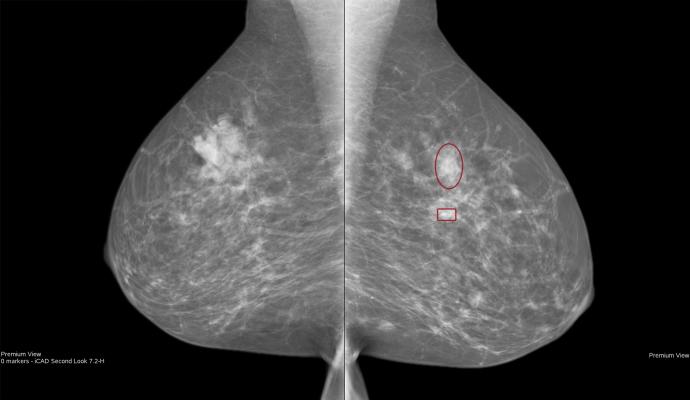
May 3, 2019 — The American Society of Breast Surgeons (ASBrS) has released the first screening mammography guidelines based on a patient’s individual breast cancer risk profile, with clear, specific strategies for screening management.
“Our members are on the front lines with breast cancer patients every day, guiding them through all stages of breast cancer diagnosis and treatment. These new recommendations were ASBrS member-driven and developed based on their unique, firsthand perspective on the disease and patient journey. They represent a deep, passionate and scientifically backed commitment to advocate for increased years of life over costs,” said Shawna Willey, M.D., FACS, ASBrS chairman of the board and professor of clinical surgery, director, MedStar Regional Breast Health Program, chief of surgery, MedStar Georgetown University Hospital, Washington, D.C. “They also aim to minimize breast cancer disparities across race and ethnicity through earlier disease detection for all.”
The new recommendations differ from current U.S. Preventive Services Task Force (USPSTF) and American Cancer Society (ACS) guidelines. Those guidelines apply only to women with average risk and also factor in screening costs per diagnosis and related issues along with mortality, but are supported by the American College of Radiology (ACR).
Drawing on the strongest body of currently available research on the impact of breast cancer screening, the guidelines recommend that all women undergo formal risk assessment by age 25. For women with average risk, they recommend annual screening starting at age 40. For women with increased likelihood of developing the disease, they call for a range of more comprehensive screening strategies based on specific risk factors.
For example, for those with a predicted breast cancer lifetime risk of ≥ 20 percent, they call for mammography and access to supplemental magnetic resonance imaging (MRI) starting at age 35. For women with breast cancer-related genetic abnormalities, they call for similar imaging starting at age 25.
“Routine screening for women age 40 to 49 has been unequivocally demonstrated to reduce mortality by 15 percent. However, today USPSTF guidelines delay annual screening until age 50 because they are based on an efficiency statistical model that also considers the impact of potential screening risks,” noted Walton A. Taylor, M.D., FACS, ASBrS president and Texas Health Physicians Group, Dallas. “In addition to elevated costs, these include a statistical probability of false negative and positive results leading to unnecessary anxiety and additional medical procedures, overdiagnosis of indolent cancers and increased radiation exposure.”
“ASBrS guidelines are based on a life-years gained model,” noted Julie Margenthaler, M.D., FACS, director of breast surgical services of the Joanne Knight Breast Center at Siteman Cancer Center, professor of surgery, Washington University School of Medicine, St. Louis. “They are based solely on the demonstrated breast cancer survival benefits. The ASBrS prioritizes life. Members put this priority to work every day when treating patients. We believe women should have an opportunity to choose earlier screening if potentially beneficial. Additionally, our understanding of breast cancer risks and risk assessment has advanced. Managing screening based on those risks is an important part of today’s personalized medicine.”
Margenthaler added, “While mammographic screening is not as easy or accurate in younger women, when we find and treat cancer, the benefits in years of life saved are highly significant. Many current guidelines will leave a subset of these women to die.”
In addition to formal breast cancer risk assessment for every woman, the new ASBrS recommendations contain many components distinguishing them from other existing academic and professional organization guidelines. These include the detailed stratification of risk, the specificity of actionable recommendations for each group, and suggestions for patient discussion and shared decision-making. The new ASBrS guidelines also take into account specific breast cancer sub-types more common among certain racial and ethnic groups. They suggest enhanced surveillance leading to earlier diagnosis and treatment in an effort to achieve healthcare equality.
While most health insurers will cover some recommended strategies such as risk assessment and 3-D mammograms before age 50, the ASBrS specifically did not restrict guidelines to currently covered procedures. “We want to be change agents on behalf of our patients and hope that these guidelines will encourage insurers to rethink some of their coverage policies,” noted Taylor.
“The ACR supports the American Society of Breast Surgeons recommendations that women start getting annual mammograms at age 40. The American Cancer Society, U.S. Preventive Services Task Force, ACR and the Society of Breast Imaging agree that the most lives are saved by this approach. Catching more cancers early by starting yearly screening at age 40 – rather than less frequent or later screening – increases the odds of successful treatment and can preserve quality of life for women. We are pleased that ASBrS has reaffirmed their support for this most sensible approach,” said Dana Smetherman, M.D., chair of the American College of Radiology Commission on Breast Imaging.
The new ASBrS guidelines and screening mammography position statement were developed by an ASBrS panel, co-chaired by Willey and Pat Whitworth, M.D., FACS, director, Nashville Breast Center.
Read the full guidelines here.
For more information: www.breastsurgeons.org


 April 18, 2024
April 18, 2024 








